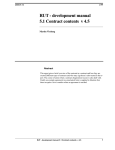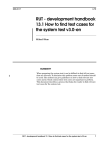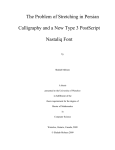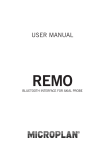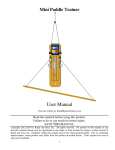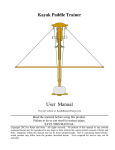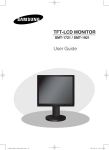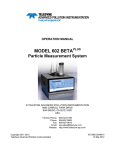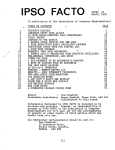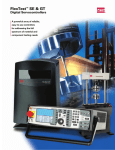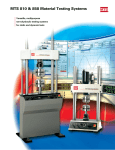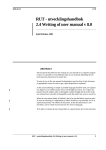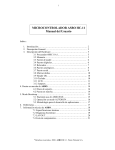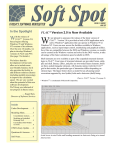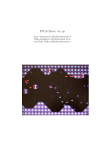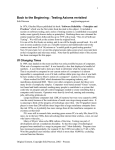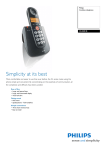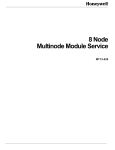Download RUT - development manual 8.11 Testing of user interfaces v4
Transcript
LiTH
2006-01-16
RUT - development manual
8.11 Testing of user interfaces
v4.0-en
Gustav Nordvall
ABSTRACT
The user interface is a large part of most software on the market today.
Since the user interface is the application’s face towards the user, it’s
very important that it is appealing and that it works well. In order to assure this, the interface must be thoroughly tested. An important category of applications in this context is active web sites, which often consist
of only one user interface and a database connection. An active web site
runs in a browser and it’s important to carefully test the user interface
in different browsers because they may often yield different results.
The purpose of this document is to describe how the process of testing
user interfaces can be planned and carried out.
RUT - development manual 8.11 Testing of user interfaces v4.0-en
1
Prerequisites
1 Field of application
The field of application for this process description is all software development with a user interface. Test methods used to test user interfaces is described for the following four test phases: the module test phase, the
integration test phase, the system test phase and the acceptance test phase.
Since this process description also describes how testing should be planned
it’s recommended to read it in the definition phase or the design phase.
2 Prerequisites
Testing of the user interface can start as soon as there is a user interface
module ready for testing, during the module test phase. When more user interface modules gets tested, their integration is ready to be tested in the integration test. Note that the implementation behind the functionality doesn’t
need to be finished to be able to test the user interface. Stubs are written for
the missing functionality which for example gives static information to the
user.
3 Realization
3.1 Overview
It’s very important to find errors early in the program development. An appropriate test strategy is to divide the test into: module test phase, integration test phase, system test phase and acceptance test phase. See figure 1 for
the different phases. How tests of the user interface might be planned and
carried out in the different phases is described in this chapter. Other parts of
the program are tested according to traditional methods, see [Bidarian,
1999]. The chapter finishes with a part consisting of active web sites and a
brief description of software, on the market, which automates the work with
testing.
Module
Integration
System
Acceptance
Figure 1: Test phases
3.2 Goals for user interface testing
As with all kinds of software testing, user interface testing strives to achieve
certain goals. The main goals of this process are bug prevention, bug symptom discovery, and bug correction diagnoses [Beizer, 1990]. Prevention of all
bugs in the user interface is naturally the ideal scenario. This saves both
time and effort later in the project since no code needs to be corrected. Although, since complete bug prevention cannot be achieved, the testing process must yield results to reach the secondary goal of bug discovery [Beizer,
2
RUT - development manual 8.11 Testing of user interfaces v4.0-en
Realization
1990]. In order to accomplish this, the testing must be thorough and divided
into small, detailed parts.
RUT - development manual 8.11 Testing of user interfaces v4.0-en
3
Realization
3.3 Detailed description - Module testing
Distribution
Even the user interface should be distributed in smaller separate parts, modules, which can be tested separate. These modules should coincide with the
other module distribution of the program. A module can for example consist
of a simple dialog box or parts of an application window. Parts that have a
large functionality should be grouped into a separate module, for example
graphic trees and tables.
Stubs
The implementation behind the presented functionality doesn’t need to be
finished to test the user interface. Missing functionality is replaced by stubs.
Stubs can be written in two ways, they either return a static code according
to a certain type, or they return “Not implemented!”. Assume the application
has a button “Start calculation”. A stub for this button could for example be a
dialog box with the text “Start calculating is not implemented yet”. Writing
stubs can be very time consuming, hence it’s good to let the test group take
part in the creation of the test-stubs which the implementation group uses in
the implementation.
Figure 2: Testing according to the top-down model, using stubs.
Test cases and test scripts
Everything that will be tested is described with test cases and test scripts,
exactly specifying what to be tested and the expected result. It should also be
test cases and test scripts which test the basic condition. I.e. a windows appearance when it’s first shown, the expected result could be compared with a
low-fi prototype [Johannesson, 1998].
What is it you look for?
4
RUT - development manual 8.11 Testing of user interfaces v4.0-en
Realization
It’s important to decide which types of errors you look for in every test phase.
In this phase, it’s important to look for misspellings and incorrect error handling. It should also be verified that the layout is appealing and functional.
It’s not enough to be satisfied with only clicking once on each button, that has
probably already been tested by the implementation group. Instead, one
should concentrate on testing incorrect error handling. Examples of what
should be tested:
■
What happens when input fields are left empty?
■
What happens when you input very long strings?
■
What happens if you input a decimal or a negative number?
■
What happens if you click on buttons in the “wrong order”?
■
Are error messages displayed when the user is doing something wrong?
Planning
Good planning is needed to for a satisfying module testing. To be able to test
the modules in a convenient manner, the implementation order needs to be
planned in advance. The implementation order should for that reason be included in the design specification. It’s also good if it is decided in advance
which parts that should be implemented as stubs before the module testing.
If the work isn’t planned carefully in advance, the implementation group will
probably implement too big parts at a time and the test group will face an
uneven workload.
3.4 Detailed description - Integration testing
Test against the underlying functionality
During the integration test, the integration between the modules of the system is to be tested. An appropriate strategy is to test the user interface
against the underlying functionality. Practically, this means that the stubs
used in the module test phase is replaced with real functions.
Test the modules against each other
When the modules of the user interface are tested with the underlying functionality, it’s time to test the modules integration with each other, e.g. according to “Bottom-up” or “Top-down”, see [Korpi, 1999] and [Rosengren, 1999]
respectively.
Test cases and test scripts
Everything to be tested should be described with test cases and test scripts,
which exactly specify what is to be tested and the expected result.
What is it you look for?
It’s important to have decided what types of errors you are looking for in every test phase. Examples of what’s supposed to be tested:
■
Is the correct information presented?
RUT - development manual 8.11 Testing of user interfaces v4.0-en
5
Realization
■
Is the information updated in the other modules when the information in
one module is changed?
■
What happens if you click on buttons in the “wrong order”?
■
Are error messages displayed when the user does something wrong?
Planning
A good planning is needed to have the integration test working satisfactory.
It’s important to have the module test phase performed in a pre-decided order so the integration test becomes a natural sequence of the modules which
have already been tested.
3.5 Detailed description - System testing
Test the complete system
The system test tests the complete system. It’s not possible to test separate
code functions any more. For that reason the system test only tests the user
interface.
Test cases and test scripts
Everything that is to be tested should be described with test cases and test
scripts, exactly specifying the expected result.
What is it you look for?
It’s important to have decided which types of errors you are looking for in every test phase. Examples of what is supposed to be tested:
■
Are all requirements in the requirement specification document met?
■
The performance should be tested for non-functional requirements.
■
Does the user manual correspond with the implementation?
The system test should cover all functionality of the program. For that reason much of what was tested during the module testing and the integration
testing might have to be tested again. The amount of test cases could be high,
but if the module test and the integration test was performed carefully, there
shouldn’t be many big errors left and the system test will become only a formal verifying.
3.6 Detailed description - Acceptance testing
Acceptance testing is similar to the system test (see 3.5), but is more focused
on testing the usability of the system rather than compliance of the code
against some specification [Van Vliet, 1996]. Usability testing includes letting a user with little or no prior knowledge of the system perform certain
tasks (see 3.9). Acceptance testing is the major criteria for whether the system will be accepted or rejected by the customer.
6
RUT - development manual 8.11 Testing of user interfaces v4.0-en
Realization
3.7 Active web sites
Distribution
Every HTML file can be seen as a module. The HTML files are often tied up
together with help of a “FRAMESET”. The stubs that are needed for the
module test and the integration test are created by modifying the different
HTML files to make them runnable in a separate browser. Many times, it
could be a good idea to write a special “FRAMESET”, which only shows a
subset of the application.
Different browsers
All testing should be done with different browsers of different versions since
they interpret the code differently in some cases. The web sites, as a result of
this, don’t look the same in different browsers. Some functionality also differ.
This is extra problematic if Java Script is used. Every test case and test
script could be used with all browser models. The test record is provided with
separate columns for the different browsers which is ticked when the different browsers pass the tests.
Test against the underlying functionality
To perform module testing and integration testing of the parts not consisting
of HTML code in an active web site is a little bit tricky since they often have
to be executed from a browser. Even the modules which only execute in the
web server often have to be started from a browser. The solution is to write
small test programs in the form of simple HTML pages, calling the modules
and presenting the result. The result can often be shown with the browser’s
“View source” function. The other solution is to use the automated test tools
discussed in the next chapter.
3.8 Automated test tools
There are tools on the market which automatically test the user interface.
These programs can be instructed to execute interaction sequences, often
done by the program “recording” user actions. Later these actions can be repeated over and over again. It usually works great to manually write test
scripts which the test tool later can execute. After the test has been executed,
the test tools have the ability to create test reports for the user to verify that
the test is performed correctly.
With other words, test tools can perform module, integration and system
testing. But they fail on the acceptance test (see 3.6) as this type of test requires users with little or no knowledge of the program being tested.
The big advantage with these types of tools is the simplicity to execute one
and the same sequence of commands with different types of input and expected result. The tools should, however, only be seen as an aid. It’s still necessary to manually specify what is to be tested; you only gain the time to
RUT - development manual 8.11 Testing of user interfaces v4.0-en
7
Realization
execute the test. Time critical test cases may also be impossible to execute
manually, which is something that these programs can handle superbly.
There are a lot of test tools available on the market today, what follows are
descriptions of some of the automated test tools:
Vermont HighTest Plus
This is an automated software testing tool especially for the Microsoft Windows environment. The testing of web sites is done through Microsoft Internet Explorer, but this tool also handles standard windows applications as
well.
HighTest Plus uses scripts to perform the testing. The scripts can be written
by yourself using the provided script language or you could record your
movements and interactions to create the script. The script language is made
of only simple commands, such as Keys{“ENTER”,6.17} that will wait 6.17
seconds and then press the ENTER key on the keyboard.
When all test scripts are written to perform various test cases, they can be
combined using HighTest's Interactive Suite Manager. That means that
more than one test script can be executed at once, peforming the desired test.
To verify the results of a test, the Vermont HighTest Plus can compare
screens, windows and files to see if the result is correct and the test is validated.
Also to take in consideration is the use of an integrated debugger. The main
purpose of this function is to go line by line in the test script to examine the
output and internal variables in the script in real time.
Moreover, a log file is created to make a detailed description of how the test
did proceed.
With this type of the testing that the tool performs, it can easily be used to
test modules in the interface and the integration with other modules.
See the Vermont web site [Vermont HighTest, 2006] for more information
about this application.
Figure 3: Screenshot of Vermont HighTest Plus.
QUOTIUM QTest
QUOTIUM QTest is an application that can perform so called “load testing”
or “software stress”. This type of test is necessary when there are a great
number of users using a web site. Basically, what the application does, is to
make a heavy load on the web server and identify where the performance is
critical. This type of test is difficult to perform by yourself as it requires a lot
of resources. Therefore QTest creates more than 10000 “virtual users” that
accesses the web site and there are possibilities to add and edit own test
scripts that the “users” should perform.
The test scripts is written in a specific language called SCL to make a inter-
8
RUT - development manual 8.11 Testing of user interfaces v4.0-en
Realization
face between the browser and the web server. And also to create what QUOTIUM calls “control points” in the web sites, to test if a certain “control point”
has been reached or not.
What QTest also offers are test scenarios, they can be created by automatic
recording of how the user interacts with any browser available. Each of these
test scenarios can then be validated, by having QTest performing them
again. Also with the use of an integrated debugger if needed for more information.
After the tests have been performed, QTest gives the user feedback by
graphs, summary list and detailed descriptions of errors identified.
Figure 4: Screenshot of QUOTIUM QTest.
See the QUOTIUM web site [QUOTIUM QTest, 2006] for more information
about this application.
TestWorks
The last example of test tools brought up is Software Research TestWorks.
There exists a lot of tools, but not so many that could handle the UNIX platform. TestWorks exists in two versions, one for the Windows and one for the
UNIX platform.
Like the other test tools, TestWorks captures the mouse movements, keyboard events and creates so called test scripts. The scripts are written in a
own language, commands like “cb_mouse_button(“LEFT”,1102,473,129)” will
press the left mouse button at the location 473, 129 on the screen after the
time 1102 milliseconds.
TestWorks is divided into three parts, the first one, regression, to execute and
records tests that is tolerant of smaller changes. Tolerant means that it contains advanced features to compare images of recorded material. The recording of tests extracts images that is compared to know if the test was a success
or not. The test scripts can be combined as with the other mentioned tools
and the results are generated and brought up to the user in a graphical way
of trees and messages.
The next part is the coverage that can tell the user if code was executed or
not, but does only works if the application was written in C, C++, Ada or
FORTRAN. Also the last part, the advisor is a code tool to measure the logic
and structure of the code to determine complexity.
RUT - development manual 8.11 Testing of user interfaces v4.0-en
9
Realization
Figure 5: Screenshot of TestWorks.
See the Software Research Inc. web site [Software Research Inc., 2006] for
more information about this application.
3.9 Usability testing
An alternative method of performing user interface tests is by implementing
usability testing. Usability testing means measuring how well people can use
some human-made object, such as a web site. The main purpose of usability
testing is to discover difficultes, such as reading instructions, manipulatin
parts or interpret the feedback people are given. If difficults are discovered,
designers need to improve the interface and test it again. Also during the test
which should be performed in as realistic a situtation as possible, the aim is
to observe and discoverer areas of improvement. To simply gather opinions is
not usability testing, you must arrange an experiment that measures a subject's ability to use the web site. [Wikipedia, 2006]
Performing a usability test involves creating a scenarios including specifed
tasks that the user should perform. An example of a scenario of a web site,
let’s say “the Current Population Survey Site”, could include tasks with questions, such as “What is the poverty rate for high school dropouts 25 years or
older?” [Usability Testing of WWW sites, 2006]. The user of the web site
would have to search for this information in the site and the observers write
down time (the time it took to complete the task), accuracy (the number of
misstakes), recall (how much the person did remember afterwards) and emotional respone (how the person feels about the task, stressed or confident).
[Wikipedia, 2006]
Usability testing can be performed in different ways. Some examples are
structured usability tests, pair usability tests, and walk-up-and-use tests
[Monk et al., 1993].
In a structured usability test a user gets a list with a set of tasks which to
solve by using the system. The user has to “think out loud” and describe how
he or she reasons. The test is monitored by and observer, and is repeated several times with different users.
In pair testing two users work together to solve a given set of tasks. A test
guide helps the users if they get stuck too long, and the test is also monitored
by an observer.
10
RUT - development manual 8.11 Testing of user interfaces v4.0-en
Results
In a walk-up-and-use test a user is presented with the user interface without
any prior information or given set of tasks. The user defines the tasks by
what he or she wants to do. This might make the testing evaluation harder to
generalize, but is the most realistic usability testing method.
4 Results
4.1 Products
The result after this process is a basis for test planning and the providing of
test cases, test scripts and test records. This will hopefully result in a user interface without errors (or at least with fewer errors).
4.2 Product templates
See chapter 5.
5 Templates and forms
Section 5.1 and section 5.2 are examples of how module test cases and module test scripts could look like for a log-on module in an active web site application.
RUT - development manual 8.11 Testing of user interfaces v4.0-en
11
Templates and forms
5.1 Example templates of test cases
MT11
MT12
MT13
Purpose
To test the base condition.
References
authentication.asp.
Input
None.
Performance
authentication.asp loaded with a browser.
Expected
results
The log-on page should be shown, consisting of a web
page which greets the user, input-fields to fill in username and password and a “Log on” button.
Purpose
To test that it’s possible to log on.
References
authentication.asp, main.asp.
Input
Valid username and valid password.
Performance
The user writes the input and clicks on “Log on”.
Expected
results
main.asp should be shown. If main.asp isn’t implemented, it’s enough to change the URL to main.asp.
Purpose
To test that an error message is received when loging
on with wrong username or password.
References
authentication.asp.
Input
Invalid username and valid password. Valid username
and invalid pasword.
Performance
The user writes the input and clicks on “Log on”.
Expected
results
A dialog window with an error message should be
shown.
Table 1: Test cases which test the authentication module.
5.2 Example templates of test scripts
MT11
1. Start Netscape Navigator 4.0 and Internet Explorer 4.0, if they aren’t al-
ready started.
2. Put in the address: http://xxx.ryd.student.liu.se/WebTRTest/authentica-
tion.asp into the browser’s address field.
3. The log-on page should appear consisting of a web site with a welcome
greeting, an input field for a username and a password, and a “Log on”
button.
MT12
1. Start Netscape Navigator 4.0 and Internet Explorer 4.0, if they aren’t al-
ready started.
12
RUT - development manual 8.11 Testing of user interfaces v4.0-en
Templates and forms
2. Put in the address: http://xxx.ryd.student.liu.se/WebTRTest/authentica-
tion.asp into the browser’s address field.
3. Put in username = “pum” and password = “pumma”.
4. The site: http://xxx.ryd.student.liu.se/WebTRTest/main.asp should ap-
pear.
MT13
1. Start Netscape Navigator 4.0 and Internet Explorer 4.0, if they aren’t al-
ready started.
2. Put in the address: http://xxx.ryd.student.liu.se/WebTRTest/authentica-
tion.asp into the browser’s address field.
3. Put in username = “pummen” and password = “pumma”.
4. A dialog window with an error message should appear.
5. Click on the “OK” button.
6. Make sure http://xxx.ryd.student.liu.se/WebTRTest/authentication.asp is
shown. The username “pummen” should still be there.
7. Put in username = “pum” and password = “pumpum”.
8. A dialog window with an error message should appear.
9. Click on the “OK” button.
10. Make sure http://xxx.ryd.student.liu.se/WebTRTest/authentication.asp is
shown. The username “pum” should still be there and that the password
input is cleared.
5.3 Example template of a test record
Module:
Test responsible:
Time consumption:
Test designer:
Date:
Tester:
Error report for test
case number:
Test secretary:
RUT - development manual 8.11 Testing of user interfaces v4.0-en
13
Verification of results
Test case
No.
Test result
Comment
OK
N
IE
6 Verification of results
It’s easy to verify the result directly in the test record, where expected results
can be compared with the real result. The work with testing is not to be regarded as finished, until all tests have been completed with a correct result.
7 Examples with explanations
Section 5.1 and section 5.2 are examples of how module test cases and module test scripts could look like for a log-on module in an active web site application.
8 Solutions to common problems
A common problem with the module testing is when the implementation
group and the test group have different opinions of the order the system
should be implemented. If the work isn’t planned correctly, the implementation group often wants to finish the system before they leave it for testing.
The result of this is that the idea of module testing falls. For that reason, it’s
important to decide during the design phase in what order the modules
should be implemented and what parts that should be implemented as stubs.
9 Adjustment to the PUM-course
This process description could be used without modification in the PUMcourse project. In recent years, it’s been common with active web sites in the
projects; this process description is particulary preferred for that type of applications.
10 Measurement of the process
10.1 Resource measurement
The time consumed to plan and perform the test of the user interface is the
measure of the resource for this process.
14
RUT - development manual 8.11 Testing of user interfaces v4.0-en
Measurement of the process
The time that’s needed to test the user interface is strongly dependent of the
complexity of the user interface. There is often a need to have many test cases to cover all functionality of the user interface. To write stubs for the module test is often a lot more time consuming than expected.
You have to be prepared to spend the same amount of time, or more, on testing the user interface as the time spent on implementing it.
10.2 Product measurement
A reasonable metric of the outcome of the testing is the amount of software
errors found by the customer one year after delivery. A high amount of errors
indicates that something went wrong during one or more test phases. To get
an idea of what went wrong during what test phase it’s a good idea to take
notes of what types of errors that occur. Measured data is combined with help
from the forms in section 10.3.
10.3 Forms for collection of data
There isn’t any need for special resource measurement forms to keep a detailed time record of the work with coding.
Example template for collecting measured data
Date
Responsible
Description
Test phase
GUI
The example template above can be used for error reports of discovered errors after delivery. The phase when the error should have been discovered is
indicated in the column “Test phase”, to get information of which test phase
that has to be improved. The column “GUI” indicates if the error was caused
by the user interface or not with a simple YES or NO. The columns
“Testphase” and “GUI” are filled in after the cause of the error has been investigated.
RUT - development manual 8.11 Testing of user interfaces v4.0-en
15
History of the process
11 History of the process
Version
Date
Changes since last version
Author
1.0sv
2000-06-13
First version.
Tomas Franzon
2.0en
2004-01-06
Translated to English.
Stefan Hjelm
2.1en
2005-01-13
Correction of spelling and grammar.
Johan Sigholm
3.0en
2005-01-14
Some new sections added.
Johan Sigholm
4.0en
2006-01-06
Spelling and grammar corrections.
Replaced the outdated automated
test tools in chapter 3.8 with new
tools with detailed descriptions.
Added extensive explanation of usuability testing to chapter 3.9.
Updated references according to the
document.
Diagram added to the overview.
Modified changes to attend to.
Gustav Nordvall
12 Changes not yet attended to
■
Evaluation of the methods needs to be improved.
■
More detailed examples in chapter 7.
■
Product templates in chapter 4.2 seems unnecessary.
13 References
13.1 Method description
[Beizer, 1990] Berizer, Boris, Software Tesing Techniques: Second Edition.
International Thomson Computer Press. ISBN 1850328803.
[Bidarian, 1999] Bidarian, Arash, Val av teststrategi v5.0, RUT - Utvecklingshandbok 12.1.
[Johannesson, 1998] Johannesson, Thomas, Framtagning av användargränssnitt mha prototyper v1.3, RUT- Utvecklingshandbok 8.2.
[Korpi, 1999] Korpi, Mikael, Testgenomförande enligt Bottom up-metoden
v4.0, RUT - Utvecklingshandbok 12.4.
[Monk et al., 1993] Monk, Andrew, et al., Improvingyour Human-Computer
Interface. Prentice Hall, Hertfordshire. ISBN 0-13-010034-X (pbk).
16
RUT - development manual 8.11 Testing of user interfaces v4.0-en
References
[Rosengren, 1999] Rosengren, Fredrik, Top-down-testning v3.0, RUT Utvecklingshandbok 12.3.
[Usability Testing of WWW Sites, 2006] http://www.bls.gov/ore/htm_papers/
st960150.htm
[Van Vliet, 1996] Van Vliet, Hans, Software engineering principles and practice. John Wiley & Sons, USA. ISBN 0-471-93611-1.
[Wikipedia, 2006] http://en.wikipedia.org/wiki/Usability_testing
[QUOTIUM QTest, 2006] http://www.quotium.com
[Vermont HighTest Plus, 2006] http://www.vtsoft.com/vcsproducts/index.html
[Software Research Inc., 2006] http://www.soft.com/TestWorks/index.html
13.2 Method evaluation
[Myers, 1979] Myers, Glenford J, The Art of Software Testing, John Wiley &
Sons, USA. ISBN 0-471-04328-1.
13.3 Internal comments
It’s not trivial to find literature describing how user interfaces should be tested. You often have to be creative when it comes to test methods. It’s not most
important to follow a specific, accepted method. The main thing is to find errors early and get an application with as few errors as possible.
RUT - development manual 8.11 Testing of user interfaces v4.0-en
17
References
18
RUT - development manual 8.11 Testing of user interfaces v4.0-en


















